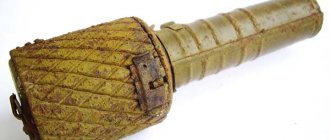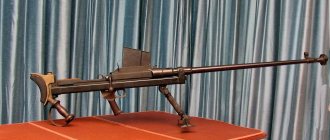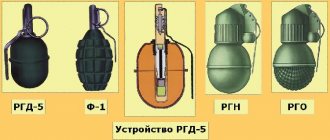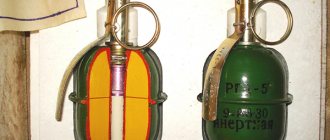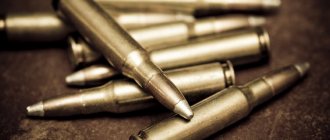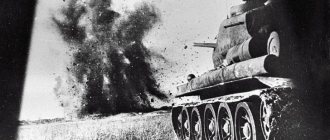In the 1930s, hand grenades, both special anti-tank and fragmentation grenades, were considered an important means of fighting tanks. The Soviet “Manual on Shooting” of 1935 and 1938 specifically indicated how to knit hand grenades model 1914/30 and RGD-33.
To make a bunch of grenades model 1914/30, it was prescribed to use 5 hand grenades loaded and put on safety cock.
The grenades were tied with twine or wire, with four of them having their handles turned in one direction, and the fifth, the middle one, in the opposite direction. When throwing, the bundle was taken by the handle of the middle grenade. Located in the middle, it served to detonate the other four, thereby serving as a kind of detonator for the entire bundle. Grenade model 1914/30
When using RGD-33 grenades, from two to four grenades were tied to the average grenade, from which the fragmentation jackets were first removed and the handles were unscrewed. It was recommended to throw the bundles from cover under the tank tracks.
Dyakonov hand grenade mod.
1933 Special anti-tank grenades were high-explosive projectiles and in this sense were the heirs to the grenades of the First World War. Their development and introduction was facilitated by the experience of the Winter War.
RPG-40
The first hand grenade, designed specifically to fight tanks, was adopted by the Red Army in 1940. It was developed by designer M.I. Puzyrev in GSKB-30 at the N58 plant named after. K.E. Voroshilov. This is a design bureau headed by N.P. Belyakov, became the leader in the development of anti-tank grenades. Serial production of the anti-tank grenade began only after June 22, 1941.
The mass of the grenade was 1,200 g, of which 760 g was an explosive - cast or pressed TNT.
The RPG-40 had a simple design and consisted of a cylindrical thin-walled body with a central channel for a fuse, an instantaneous fuse, an explosive charge, a handle with an impact mechanism and a safety mechanism, and a fuse. Instructions for its use were applied to the body.
The connection of the handle to the body is carried out by screwing it onto the stump of the central tube (protruded 7-8 mm) of the grenade body. For this purpose, a threaded flange is fixed in the upper part of the handle. A stationary tube is placed inside the handle body, which is attached to the handle body with rivets and a washer. On the side surface of the handle, in the upper part, there is an eyelet welded, which serves to secure the folding bar using a cotter pin. The opening below the eyelet includes a safety lug for the flap. There is a hole at the bottom of the handle body to accommodate the flap tooth.
The impact mechanism is placed in the handle and consists of a striker with a sting, a mainspring, a movable tube with a stop, a stop loop, a needle loop, an inertial weight and two balls.
The striker with a sting is used to pierce the detonator cap of the fuse. On the side surface of the striker there is an annular recess in which the balls are placed. The sting is fixed in the striker and its tip is directed towards the central tube of the grenade (fuse). The striker with the sting is placed inside the movable tube. The movable tube is used to assemble the mainspring, striker with sting and balls. It is inserted into a stationary tube.
The mainspring imparts to the firing pin the movement necessary to puncture the detonator cap. The balls keep the firing pin cocked. They fit into the holes in the wall of the movable tube with one half and into the annular groove of the striker with the other. The movable tube has two diametrically located holes for placing balls. They are kept from falling out by the walls of the fixed tube.
The hole located above the ball holes serves to accommodate the safety bar. At the wide end of the movable tube there is a stop that serves to support the spring and to fasten the stop loop. A needle loop is connected to the stop loop, which serves to hold the striking mechanism in the firing position.
The inertial weight is designed to lower the impact mechanism - one end of it rests against the bottom of the handle, and the other against the wide end of the movable tube.
The safety mechanism consists of a folding bar with a needle and tendril and a cotter pin. The hinged bar is used to remove the needle during the flight of the grenade in order to release the impact mechanism. The needle is connected to a folding bar and holds the striking mechanism in the cocked state. The tendril serves as an additional safety device in case the needle loop comes off during transportation. A cotter pin (pin) with a tongue made of braid secures the folding bar to the handle body.
The instantaneous fuse is designed to detonate the explosive charge of a grenade. It consists of a detonator capsule, an igniter sleeve, an igniter sleeve and an additional detonator. The detonator for the RPG-40 looked similar to the RGD-33 detonator, but had a slightly longer length - 95.7 mm (88.7 mm for the RGD-33) and was distinguished by the absence of deceleration when triggered.
The striking mechanism was always cocked and held in the stowed position by a safety mechanism. The ends of the cotter pin (pins) are spread apart and firmly hold it from falling out. The bar antenna fits into the holes of the handle body, fixed and movable tubes and is located in front of the striker. The movable tube is in its rearmost position and is held (by a loop) by the folding bar needle. The inertial load is clamped between the bottom of the handle and the movable tube.
In preparation for throwing, the instructions instructed to take the grenade by the handle in your right hand, pressing the safety bar tightly, and with your left hand to slide the bolt in the upper part of the grenade body, insert the detonator into the central channel and push the lid back in. It was allowed to equip grenades with detonators only immediately before throwing, and therefore they were stored separately in the stowed position.
Before throwing the RPG-40, the safety pin was pulled out by the braid and after that the folding bar was held only by hand.
When a grenade was thrown, it separated, removing the needle and releasing the firing mechanism. When a grenade hits an obstacle, the movable tube moves under the influence of an inertial load, regardless of where the grenade hit.
As the movable tube moves forward, the holes in it, in which the balls are placed, are installed opposite the windows in the stationary tube. The balls holding the firing pin on the firing pin fall out and release the firing pin. The latter, under the action of the mainspring, moves forward and punctures the capsule, which causes an instant explosion.
The explosion occurred regardless of where the grenade hit the obstacle. The high sensitivity of the impact mechanism led to the fact that without a safety needle, to trigger the RPG-40 it was enough to simply drop it on the ground.
The grenade's throwing range was 20-25 meters, and thanks to its high-explosive action, it was capable of destroying armor up to 20 mm thick. When throwing a grenade at a tank, it was necessary to hit its most vulnerable places: the roof of the turret or engine compartment, the tracks. The destructive radius of the grenade is 20 m.
High-explosive grenades were also intended to destroy field fortifications. Throwing was ordered to be carried out only from behind cover, and not to destroy triggered grenades by detonating another grenade or shooting from a rifle. It was strictly forbidden to touch unexploded grenades.
If the loaded grenade was not thrown, then it is necessary, without releasing the strips, to insert the cotter pin, separate its ends and unload the grenade.
RPG-41
In terms of armor penetration, the RPG-40 soon ceased to meet the requirements of anti-tank weapons - when it exploded on the surface of armor more than 20 mm thick, it left only a dent, without causing dangerous spalls of the armor from the inside.
In connection with the strengthening of armor protection of M.I. tanks. Puzyrev already in 1941 created a more powerful RPG-41 grenade. The explosive charge was increased to 1,400 g, which increased armor penetration by 5 mm. However, the increase in the mass of the grenade led to a decrease in the range of its throw. This circumstance, as well as the insufficient armor-piercing effect on tanks, did not contribute to the widespread use of the RPG-41.
Production of the RPG-40 was discontinued in 1943 after the introduction of the RPG-43 cumulative grenade. However, the high-explosive anti-tank grenade was in service for quite some time. A kind of revision of all types of weapons of the Red Army carried out at the end of the war left the RPG-40 in service along with the RPG-43.
Perhaps the reason for this is that a powerful high-explosive grenade was in demand during storming of buildings and destruction of field fortifications. A kind of revival of the engineering grenade.
The RPG-40 was removed from service no later than 1956.
After the war, the USSR supplied the grenade to its allies. During the Korean War, the RPG-40 was used by both the Korean People's Army and Chinese volunteers.
In July 1941, the Military Council of the Northern Front issued an order to develop an anti-tank hand grenade for production in Leningrad. 3 days were allocated for the development of the grenade project. Inventor A.N. Selyankin with the participation of designer M.G. Dyakonova created a high-explosive anti-tank grenade based on the RGD-33 with an explosive charge increased to 1 kg, also designated RPG-41.
A cylindrical tin can measuring 94x127 mm was attached to the handle of the RGD-33, which had a channel inside for an igniter and could hold 1 kg of explosives. Because of this, the grenade received the unofficial name “Voroshilov kilogram”. The use of a fuse from the RGD-33 led to the fact that the grenade turned out to be remote (the moderator burns for 3.6 seconds), and this negatively affected its effectiveness. The fuse from the RGD-33 did not fit in length - it turned out to be short, and after installation it was pressed on top with a wooden or bakelite plug (during the tests, a pencil stub was used to increase the fuse). Already on July 10, it was decided to produce 100,000 grenades within a month. They gave the same amount of time to organize production as to develop a grenade - 3 days. During the second half of 1941, 798,000 RPG-41 grenades were fired in Leningrad.
Specifications
The main parameters of the M24 grenade are as follows:
| Weight | 595 grams |
| Explosive weight | Up to 180 grams |
| Length | 36.5 cm |
| Diameter | 70 mm |
| Radius of action | 15 meters (without fragmentation jacket) |
| Maximum flight distance of fragments | Up to 100 meters (grenade in a shirt) |
| Moderator burning time | 4.5-5 seconds |
The radius of dispersion of fragments and the “destructive force” of a grenade largely depended on the type of explosive used. Apparently, the “beaters” stuffed with picric acid had the most powerful high-explosive effect.
RPG-43
In mid-1943, the Red Army adopted a fundamentally new cumulative action grenade, RPG-43, developed by N.P. Belyakov. This was the first cumulative hand grenade developed in the USSR.
The RPG-43 grenade had a body with a flat bottom and a conical lid, a wooden handle with a safety mechanism, a band stabilizer and an impact-igniting mechanism with a fuse. Inside the case is placed a bursting charge with a cumulative conical recess lined with a thin layer of metal, and a cup with a safety spring and a sting fixed in its bottom.
The cup is located in the tube of the conical housing cover, which serves to connect the housing to the handle. For this purpose, the tube is threaded.
The wooden handle of the grenade has a complex design. At its front end there is a metal sleeve, inside which there is an ignition holder and a pin holding it in the rearmost position. On the outside, a spring is put on the bushing and fabric tapes are laid, attached to the stabilizer cap. The cap serves to protect the belts from external influences during transportation and to improve stabilization during grenade flight. The safety mechanism consists of a folding bar and a pin. The hinged bar serves to hold the stabilizer cap on the grenade handle before it is thrown, preventing it from sliding or turning in place.
When bringing the grenade into firing position, it is necessary to insert the fuse. To do this, the handle is unscrewed and, having first made sure that the safety spring and the tip are in the housing cup (inspect and lightly press the spring with your finger), the fuse is screwed onto the fuse holder until it is tight.
When performing this operation, the handle is held with the left hand with the fuse holder up, and the fuse is screwed on with the right.
Before throwing the grenade, the grenade is taken in the right hand, while the folding bar is pressed tightly against the handle, and the safety pin is pulled out by the ring with the left hand. After the pin is pulled, you should make an energetic swing and throw the grenade.
When throwing a grenade, the hinged bar separates and releases the stabilizer cap, which, under the action of a spring, slides off the handle and pulls the tapes behind it.
The safety pin falls out under its own weight, releasing the fuse holder. During flight, the igniter holder with the igniter is kept from moving forward only by a safety spring. Thanks to the presence of a stabilizer, the grenade flew head-first, which is necessary for optimal use of the energy of the grenade's cumulative charge. When a grenade hits an obstacle with the bottom of the body, the fuse, overcoming the resistance of the safety spring, is impaled on the sting by a detonator cap, which causes the explosive charge to detonate. The RPG-43's shaped charge penetrated armor up to 75 mm thick.
Advantages and disadvantages
Stielhandgranate M24 has several undoubted advantages:
- The simplicity of the device and the associated manufacturability, which made it possible to produce tens of millions of grenades;
- Ease of throwing. The long handle makes it possible to throw a grenade 40-50 meters without much effort. In addition, good accuracy is ensured;
- Easy and at the same time safe handling of the grenade.
At the same time, it should be noted that in general the “mallet” was already an obsolete weapon by the beginning of World War II. Its main disadvantage was its insufficiently high reliability. There were two reasons for this: firstly, explosives based on ammonium nitrate do not survive long-term storage, gradually losing the ability to detonate. Secondly, the insufficiently high tightness of the structure led to dampness of the igniters and moderators. As a result, sometimes the fuse did not fire, and sometimes the main charge “did not want” to detonate.
M24 grenade carrying box
In addition, the very use of a grating ignition mechanism can already be considered a disadvantage. Because of this feature, after pulling out the ignition cord, it was necessary to immediately throw the “mallet”, which was not always convenient. More modern fuses made it possible to hold a grenade with the pin pulled out in your hand, waiting for the optimal moment to throw it.
British soldiers, who sometimes had to use captured “mallets,” noted that in open areas the effect of such grenades was extremely weak. Finally, complaints arose very often due to the excessively long combustion of the moderator, which often lasted up to eight seconds.
